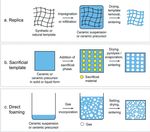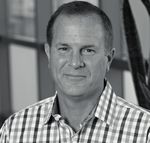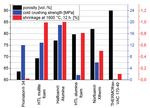Cost Efficient Directly Foamed Ceramics for High Temperature Thermal Insulation
←
→
Page content transcription
If your browser does not render page correctly, please read the page content below
TECHNOLOGY INSIGHTS COMPONENTS
Cost-Efficient Directly Foamed
Ceramics for High-Temperature
Thermal Insulation
Highly insulating materials are key factors for energy-efficient thermal
processes. While fibre-based insulation panels provide excellent thermal
insulation, they suffer from poor mechanical strength and abrasion
resistance. Furthermore, high prices due to high production costs and the
release of fibre dust are disadvantages in their practical application.
Lightweight refractory bricks, on the contrary, are inexpensive and
mechanically stable, but exhibit a high thermal mass and high thermal
conductivity. Highly porous directly foamed ceramics, also referred to as
ceramic foams, are an alternative capable of filling the gap between fibre-
based insulation panels and lightweight refractory bricks in thermal
insulation. The Fraunhofer Center HTL/DE has developed a direct foaming
process to produce cost-efficient ceramic foams for high-temperature
insulation.
Introduction spective elements also have to be kept low The sintering of ceramic hollow beads is
Thermal insulation materials are used to be competitive [1]. an alternative, which leads to parts with
to spatially and thermally separate the In order to keep the overall costs for in a generally high compressive strength,
chambers of furnaces from the surround sulation low, furnace walls, especially in yet limited maximum porosity and high
ing. They have to fulfil several require large furnaces, are often built up from prices for raw materials. It is mostly used
ments in their practical application. First of several layers of insulating materials. They in lightweight engineering and for kiln fur
all, they have to be thermally, chemically are assorted along the temperature gradi niture. Via Additive Manufacturing (AM),
and dimensionally stable up to the max ent from the furnace chamber to the ambi near-net-shape porous parts with tailored
imum service temperature. Furthermore, ance in terms of maximum service tem pore structures can be fabricated with a
insulation materials need to provide min perature, thermal conductivity, mechanical high material efficiency. AM is therefore
imal thermal conductivity for good thermal stability and price [2]. particularly suited for the production of in
insulation and low space requirements. Generally, a low thermal conductivity dividualized and load-oriented bone scaf
In addition, the mechanical and thermo can be achieved by the implementation fold structures made of more expensive
mechanical stability has to be high enough of pores into a host material. In case of raw material, so the process-related high
to bear the load of structural elements ceramics, several manufacturing routes costs for the production of the parts are
positioned above them. In case of batch have been developed, which include par mitigated [3].
furnaces, thermal cycling resistance is tial sintering, additive manufacturing, hol
also essential for a long service life. Due low bead sintering, sacrificial templating, Joachim Vogt
to the considerable volume of thermal in replica foams and direct foaming. Fraunhofer ISC / Center for
sulation in furnaces, the prices of the re Partial sintering of coarse-grained masses, High-Temperature Materials
and Design HTL
e.g., is an easy and cost-effective way to 95448 Bayreuth, Germany
achieve refractory products with lowered
Keywords E-mail: joachim.vogt@isc.fraunhofer.de
ceramic foams, thermal insulation, densities, but leads to a limited specific
www.htl.fraunhofer.de
direct foaming strength and limited maximum porosity.
50 CERAMICAPPLICATIONS 7 (2019) [1]COMPONENTS TECHNOLOGY INSIGHTS
For a more straightforward production of
highly porous ceramics, three main fabri
cation routes can be determined (Fig. 1).
The so-called replica method (RM) is
based on coherent natural or synthetic
cellular structures such as polyurethane
foams as sacrificial bodies. The pores of
the cellular structures are infiltrated with
ceramic slurries or preceramic com
pounds, and the cellular structures are
then burnt out before sintering, which
relieves the final replica foam. In using
this technique, extremely high porosities
up to 92 vol.-% with predominantly large
open pores are accessible, which is why
this process technique has been estab
lished for the production of ceramic filter
elements or catalyst carriers [4]. Likewise,
the burning of a large volume of hydro
carbons in order to get a small volume
fraction of ceramic material leads to long
burning times and a high carbon dioxide
footprint, and the foam struts are prone to
break during p yrolysis [5].
The sacrificial templating method (STM) Fig. 1
uses placeholders such as natural or Schemes of the three principal routes
to obtain highly porous ceramics [4]
synthetic hydrocarbons, liquids, or met
als during moulding, which are dispersed
in the ceramic raw material and relieved corporation of gases into ceramic precur Among them are thermosetting polymers
via pyrolysis, evaporation, sublimation sor materials to establish porosities up to or polysaccharides, thermosetting or pH-
or leaching before the actual sintering +95 vol.-% in the most material efficient setting herbal or animal proteins, mono
process. In using this technique, a broad way [4]. In direct foaming, in turn, three mers conducting radical polymerization,
range of porosities from 20–90 vol.-% is main routes can be outlined. Chemical hydraulically setting cements, and sol-
accessible. Furthermore, the pore shape direct foaming uses gas formation dur gel precursors. Directly foamed ceramics
and the size distribution can be tailored ing chemical reactions in order to produce have recently been commercialized [6, 7].
in a broad range by the choice of suitable gas bubbles in ceramic slurries or precer The production of cost-efficient highly
sacrificial raw materials. Also closed pores amic polymers. Physical direct foaming porous ceramics requires inexpensive
are accessible. The drawback of the STM utilises the incorporation of gas into the raw materials and processes. Therefore,
technique lies in the removal step of the liquid phase via gas pressure and bubble mechanical direct foaming of water-
placeholders: the burning of large volumes formation upon pressure drop. In mechan based ceramic slurries is an interesting
of hydrocarbons, e.g., leads to high gas ical direct foaming, gas bubbles of the approach. At the Fraunhofer Center HTL,
pressures inside the green parts, so long surrounding air are injected into mainly a direct foaming process of this type has
burnout times have to be chosen to avoid water-based slurries via turbulent stirring. been developed and patented [8]. It aims
crack formation. Furthermore, the elimin Therefore, suitable surfactants have to be at competitive highly porous ceramics for
ation of organic placeholders is likely to chosen in order to provide for an adequate the use as durable insulation material, es
cause cracks and results in a large car foamability and short-term foam stabilisa pecially for temperatures >1400 °C [9].
bon dioxide footprint. When using liquids tion.
or metals as templates, the extensive Concerning all of these approaches, long- Experimental
sublimation or leaching steps cause high term foam stabilisation against bubble co The practical realisation of the manufac
costs per volume and low throughput [4]. alescence, Ostwald ripening and drainage turing process is depicted in Fig. 2. At
is essential to yield stable ceramic foams first, a slurry is prepared, which contains
Direct foaming with high porosities and a homogeneous deionized water, ceramic particles, as
When thinking about the production of pore structure. Therefore, mostly gellants sociative thickeners and a plant-based
highly porous ceramic bodies, why not use are used to freeze the foam structure, gelling agent. Associative thickeners are
gases or even surrounding air as a main before foam aging and collapse can oc commonly used in the food and cosmetics
raw material? Direct foaming processes cur. Up to now, a diverse range of gellants industry in order to thicken water-based
use the formation of gases in or the in has been used to stabilise ceramic foams. formulations like creams and pastes in a
CERAMICAPPLICATIONS 7 (2019) [1] 51TECHNOLOGY INSIGHTS COMPONENTS
moderately flowable. Using shape moulds
and flowable slurry foams, near-net shape
fabrication becomes possible depending
on the geometrical details of the parts.
The filled moulds are then placed in an
oven to be thermally treated for gelation
and drying at temperaturesCOMPONENTS TECHNOLOGY INSIGHTS
conditions during thermal treatment for
gelation and drying, foams with open por
osities ranging from 55–85 vol.-% can be
obtained. The resulting pores are intercon
nected and vary in a range of 20–400 µm
(Fig. 5). Porosity, pore size and pore size
distribution can be controlled via slurry
rheology. Fig. 6 shows some values for
the porosity, cold crushing strength and
permanent linear shrinkage after thermal
treatment for ceramic foams developed at
the Fraunhofer Center HTL, in comparison
to commercial foams, refractory bricks
and vacuum-based panels.
Ceramic foams can reach the mechanical
strength of refractory bricks, while having
a considerably higher porosity. Accordingly,
low thermal conductivity values especially
at high temperatures can be achieved de Fig. 5
pending on the raw materials used, and SEM-picture of the microstructure of a mullite foam with a porosity of about 70 vol.-%
(magnification 25×, working distance 15 mm, EHT 10 kV, secondary electron detector)
the actual porosity and the pore structure
obtained (Fig. 7). The values of the ther
mal conductivity for ceramic foams are
only factor two to three times as high as treatment, production costs in the range of fabricate highly porous ceramics for in
for high-temperature vacuum insulation refractory bricks can be reached [10]. sulation applications. The porosities as
panels, while the foams exhibit a signifi well as thermal and mechanical proper
cantly higher compressive strength. Due Conclusions ties achieved are in between refractory
to the use of inexpensive raw materials, Direct foaming of water-based slurries fibre bricks and fibre-based insulation
the simple process and the fast thermal is a cost-efficient and easy approach to panels. The raw materials, the process
Fig. 6 Fig. 7
Porosity, cold crushing strength and permanent linear shrinkage after 12 h Comparison of the thermal conductivity values
at 1600 °C of directly foamed ceramics developed at the Fraunhofer Center HTL of the samples mentioned in Fig. 6
in comparison to commercial high-temperature lightweight firebrick
(Promaton® 34), commercial alumina foam (Halfoam® Alumina), commercial
mullite-zirconia foam (Norfoam® Xtherm) and fibre-based vacuum-formed
sheet (THERMOfrax-VAC 170-40)
CERAMICAPPLICATIONS 7 (2019) [1] 53SPEAKERS INCLUDE:
Michael Silver,
CEO,
American Elements
Willard Cutler,
Technology Director,
Corning
I-X Center, Cleveland, Ohio, USA
Exhibits and Conference: April 30-May 1, 2019
Welcome Reception (invite only): April 29, 2019
The ceramic industry’s
Chris Duchene,
Global VP of Supply Chain,
CoorsTek
leading free-to-attend
conference returns to Mark DiPerri,
Cleveland, Ohio! Business Development
Manager, Advanced
Materials Division,
Toshiba America Electronic
Components Inc.
Reasons to attend
Be the first to hear about the latest Richard Gulotty,
Engineer III, Friction
material and manufacturing developments Materials Engineering,
Honeywell Aerospace
Refine your manufacturing processes with
new techniques learnt at the conference
Discover new applications in end-user Kayleigh Porter,
markets for advanced ceramics and glass Additive Ceramic
Development Lead,
HRL Laboratories LLC
Keep up-to-date with changing markets
and regulations for new materials Remember to view the full
agenda and speaker list at
ceramicsexpousa.com/
conference
REGISTER FOR YOUR FREE PASS WWW.CERAMICSEXPOUSA.COM
Key topics: additive manufacturing • electro-ceramics • polymer derived ceramics • sourcing raw
materials • market growth • R&D processes • thermal management • end-user applicationsCOMPONENTS TECHNOLOGY INSIGHTS
itself and the required equipment are in lower than fibre-based insulation panels and effective insulation components.
expensive, and the thermal processes can and also well below polycrystalline fi Considering the broad range of materials
be conducted efficiently. Therefore, the bre wools. The foams can be shaped via and achievable properties and shapes,
overall production costs are estimated moulding and plastic deformation during also other applications like lightweight kiln
to be in the range of lightweight refrac gelling. Therefore, they can be used for furniture, hot gas filtration or bio-scaffolds
tory bricks, but an order of magnitude near-net-shaped, inexpensive yet stable can possibly be served.
References
[1] Raether, F. (ed.): Energieeffizienz bei der Amer. Ceram. Soc. 89 [6] (2006) 1771– [7] https://www.ceramicindustry.com/
Keramikherstellung. Frankfurt/M. 2013 1789 articles/96585-designing-the-next-
[2] Routschka, G.: Praxishandbuch Feuer [5] Colombo, P.: Ceramic foams: fabrica- generation-of-ceramic-insulation
feste Werkstoffe, Chapter 7, Essen 2011 tion, properties and applications. Key [8] DE102018200969 B3 – Verfahren zur
[3] Hammel, E.C.; Ighodaro, O.L.-R.; Okoli, Engin. Mater. 206–213 (2002) 1913– Herstellung poröser anorganischer Form
O.I.: Processing and properties of ad 1918 körper sowie damit hergestellte Form
vanced porous ceramics: An application- [6] https://www.pressebox.de/presse körper und deren Verwendung
based review, Ceram. Int. 40 (2014) mitteilung/morgan-advanced-materials/ [9] https://www.htl-enertherm.eu
15351–15370 HalFoam-komplettiert-Morgans- [10] Raether, F. (ed.): Nachhaltige Wärme
[4] Studart, A.R.; et al.: Processing routes to umfangreiches-Portfolio- behandlungsprozesse systematisch
macroporous ceramics: A review. J. poroeser-Werkstoffe/boxid/747670 entwickeln. Frankfurt/M. 2018
Know-how | Engineering | Solutions
Customised Promat thermal insulation for ceramics manufacture
Industrial applications benefit from the use of a Promat insulation system to minimise heat losses and to allow better process stability.
Promat insulation is thinner, lighter and more efficient and will help you achieve the best possible cost and operational efficiency,
while respecting the design of your application.
Etex Building Performance GmbH, Divsion Etex Industry, P.O. Box 101564, D-40835 Ratingen
+49 (0)2102 493-0 | industry.verkauf@promat.de | www.promat-industry.deYou can also read



























































